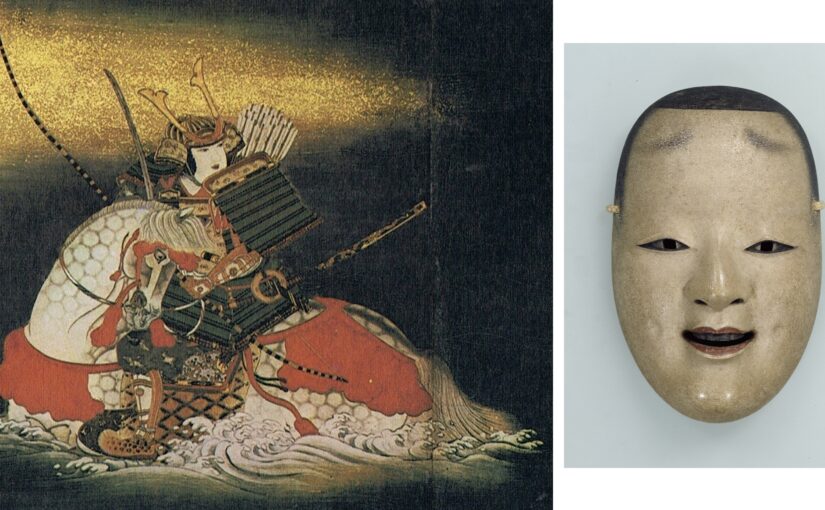Noh Plays are full of Ghosts
Photo: “Ichi-no-Tani Battle Map Screen” held by Eisei Bunko, Noh Mask
Story of Noh Play “Atsumori” (敦盛)
Atsumori was only 16 years old when he was killed by Kumagai at the battlefield of Ichi no tani.
It was not easy even for a fierce samurai worrier of Genji Clan like Kumagai to take the life of a young man who was about the same age as his own son. Atsumori’s face was so beautiful, and he even had a slight makeup.
Only after the war was over did Kumagai find out that the boy was Atsumori, Heike’s prominent family member, famous for his talent as a flute player.
Kumagai, who renounced the world and became a Buddhist priest now called Rensei, was traveling through Ichi no Tani. One day he heard the beautiful sound of a flute. It turned out that one of the three grass-cutters was playing it. The guy asked Rensei to recite the prayer of Amitabha Buddha ten times. To the suspicious Rensei, the guy hinted that he had some connection to Atsumori, and left.
That night, when Rensei was praying for the peace of Atsumori’s spirit, Atsumori’s ghost appeared in his battle attire. Thanking Rensei for his kind gesture, Atsumori the ghost began dancing, depicting his last day, the battle with Kumagai (now Rensei), and how he had fallen.
After the dance, Atsumori’s ghost addressed Rensei as his close friend, not an enemy, asked Rensei to pray for his soul, and disappeared…
Both Atsumori (Taira no Atsumori 平敦盛 1169 – 1184) and Kumagai (Kumagai Jiro Naozane 熊谷次郎直実 1141 – 1207) are real historical figures. The battle of Ichi no tani also really happened, and is one of the most famous that is depicted in the Tale of Heike.
In junior high, the excerpt of this battle was included in our textbook as “Atsumori no Saigo” (The Last Moment of Atsumori). I used to hate reading classic Japanese because it was so different from the modern spoken Japanese and painfully difficult to understand. But somehow this tragic story resonated with me, and I can still recite the phrase “Naku naku kubiwo zo kaiten geru (with tears (he) cut the neck).
Resurrecting Atsumori as a ghost, the playwright Zeami Motokiyo (1363 – 1443) took up this tragedy and turned it to a beautiful Noh play of friendship. Even though the character is no longer alive and it’s only a play, I’m somewhat relieved that Kumagai and Atsumori were able to forgo their hatred and make peace with each other.
Halloween is coming up this year. I haven’t figured out yet why, but there are a lot of ghost stories in Noh, a major form of classical Japanese dance-drama that has been performed since the 14th century. This month would like to share with you some of my favorite ghost stories from the Noh plays.
How did you like this Atsumori story?
